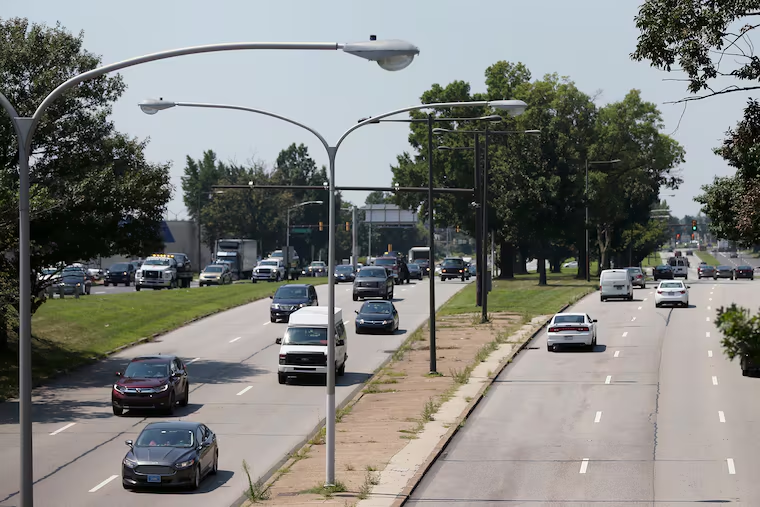The longed-for Roosevelt Boulevard subway is drawing new interest. Could it happen?
Proposals for a subway along Roosevelt Boulevard stretch back 109 years. It's a popular idea but there are hurdles.

Philadelphia’s idea to build a Roosevelt Boulevard subway has lived on paper since 1913. The notion refuses to die after 109 years, even though city and state authorities turned aside a number of serious proposals in the 1920s, the 1940s, the 1960s, and 2003.
Now some transit experts and elected officials think it might be time to stop fighting this zombie.
A Roosevelt Boulevard subway still fires the imaginations of regional and city planners — and probably more than a few drivers stuck in traffic on Northeast Philadelphia’s main artery, one of the nation’s deadliest roads. Proponents say billions in new federal money from the 2021 infrastructure law could help make the Boulevard subway real, reducing traffic and crashes and spurring growth.
State Rep. Jared Solomon, a Democrat who represents part of Northeast Philadelphia, has scheduled a public airing at a town-hall meeting Aug. 27 at the PATH (People Acting to Help) center near the intersection of Castor and Cottman Avenues.
“The pandemic offers us all an opportunity to rethink where we are and where we’re going,” Solomon said. “The Boulevard has so much potential. At some point we’re going to have to pull off the Band-Aid and do something.”
He said he’s not wedded to a subway or any other ideas to better connect the Northeast and foster economic growth, such as Bus Rapid Transit, featuring dedicated lanes where buses could slice through traffic. “I want to see where the dialog takes us,” Solomon said.
Noting the installation of red-light and speed enforcement cameras and SEPTA’s Boulevard Direct express bus service, he said: “We’re actually farther along than we thought.”
Over time, the cost of building a Roosevelt Boulevard subway — estimated at up to $3.4 billion in 2000 dollars — has naturally jumped, and federal grants to expand “heavy rail” service still require states and cities to pay a share, usually about 50%.
In addition, SEPTA would have to compete with transit agencies around the U.S. for that money and, in a sense, against itself, since it’s proceeding with a planned $2 billion rail extension to King of Prussia. A Roosevelt Boulevard rail line is not in the agency’s current plans.
The original proposal, under Mayor Rudolph Blankenburg (known as the ”Old Dutch Cleanser” for his progressive thinking), was to build an elevated train line along the length of Roosevelt Boulevard. A surface light-rail line and a subway have also been considered — the latter as an extension of the Broad Street Line with a mile-long spur connecting Bustleton to the Market-Frankford Line.
In 2003, a study submitted to Philadelphia planners by six engineering and design firms estimated such a subway extension in the median of the roadway could be built within 10 years. It would draw an estimated 124,500 weekday riders, they concluded.
By 2021, the Route for Change report on the future of Roosevelt Boulevard, prepared by the city, SEPTA, and PennDot, recommended bus rapid transit with separate lanes by 2040 and offered two alternative designs: a $10.8 billion partially capped expressway that would have dedicated rapid bus lanes, protected bike lanes, and local traffic on the surface; and a $1.9 billion plan for a slower-speed roadway with dedicated bus lanes, flex lanes (which could be used for on-street parking in nonpeak hours), and bike lanes.
“These other forms of transit are not going to lead to the kind of economic development a heavy rail subway would,” said Jay Arzu, a doctoral student in regional and city planning at the University of Pennsylvania who advocates the subway. “It could be a boon to the Northeast and the city.”
The line could be built in stages and lower costs by using “cut and cover” construction that sinks the tracks below grade and caps them with a roof, as opposed to boring a deep tunnel, he said. Leaders could seek other funding, he suggests, such as climate-change grants from the Environmental Protection Agency or public-private partnerships.
Arzu said the first step would be an updated study on the feasibility of a Roosevelt Boulevard subway. He’s going to continue pushing to get the idea considered.
“It’s about a mind-set,” he said. “You’ve got to believe. That’s how we progress.”
While SEPTA did not include Boulevard rail in its recently passed 12-year capital spending plan, the agency is not exactly dousing the idea with cold water either.
“We’re interested to see what comes up in these discussions,” spokesperson Andrew Busch said. “A lot of projects start this way.”